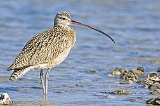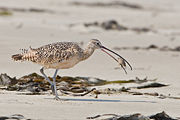
Long-billed Curlew
Encyclopedia
The Long-billed Curlew, Numenius americanus, is a large North America
n shorebird of the family
Scolopacidae
. This species was also called "sicklebird" and the "candlestick bird". The species is native to central and western North America. In the winter, the species migrates southwards, as well as towards the coastline.
as the longest bill of any shorebird. Adults have a very long bill curved downwards, a long neck and a small head. The neck and underparts are a light cinnamon, while the crown is streaked with brown. This species exhibits sexual dimorphism
, the female having a much longer bill than the male.
 Their breeding habitat is grasslands in west-central North America
Their breeding habitat is grasslands in west-central North America
. The species displays an elaborate courtship dance during breeding season. Fast and looping display flights are also common. A small hollow is lined with various weeds and grasses to serve as the nest. Four eggs are always laid as this is a characteristic of shorebirds. The eggs vary in hue from white to olive. The Long-billed Curlew is a precocial bird, and the chicks leave the nest soon after hatching. Both parents look after the young.
 The bird usually feeds in flocks. Using its long bill, it probes the mud near its habitat, foraging for suitable food. The usual food consists of crabs and various other small invertebrates. The species also feeds on grasshoppers, beetles and other insects. This bird has occasionally been known to eat the eggs of other birds.
The bird usually feeds in flocks. Using its long bill, it probes the mud near its habitat, foraging for suitable food. The usual food consists of crabs and various other small invertebrates. The species also feeds on grasshoppers, beetles and other insects. This bird has occasionally been known to eat the eggs of other birds.
species by the IUCN, but new research has confirmed that the Long-billed Curlew is again common and widespread (Jones et al. 2008). Consequently, it is downlisted to Least Concern
status in 2008.
Candlestick Point in San Francisco
was named after this indigenous bird, and subsequently Candlestick Park stadium inherited the name. Ironically, the species had dramatically declined in the San Francisco area by the early 20th century already, being "practically extinct
" in San Mateo County
in 1916. By the time the stadium was constructed in the 1950s, the last remnants of the flocks of "candlestick birds" - which formerly numbered in the thousands - were being shot by hunters until, at least temporarily, none were left.
North America
North America is a continent wholly within the Northern Hemisphere and almost wholly within the Western Hemisphere. It is also considered a northern subcontinent of the Americas...
n shorebird of the family
Family (biology)
In biological classification, family is* a taxonomic rank. Other well-known ranks are life, domain, kingdom, phylum, class, order, genus, and species, with family fitting between order and genus. As for the other well-known ranks, there is the option of an immediately lower rank, indicated by the...
Scolopacidae
Scolopacidae
The sandpipers are a large family, Scolopacidae, of waders or shorebirds. They include many species called sandpipers, as well as those called by names such as curlew and snipe. The majority of these species eat small invertebrates picked out of the mud or soil...
. This species was also called "sicklebird" and the "candlestick bird". The species is native to central and western North America. In the winter, the species migrates southwards, as well as towards the coastline.
Appearance
The Long-billed Curlew is the largest nesting or regularly-occurring sandpiper in North America. It is 50–65 cm (19.7–25.6 in) long, 62–90 cm (24.4–35.4 in) across the wing and weighs 490–950 g (1.1–2.1 lb). Its extremely long bill measures 11.3–21.9 cm (4.4–8.6 in), and rivals the bill of the larger-bodied Far Eastern CurlewFar Eastern Curlew
The Far Eastern Curlew or Eastern Curlew is a large shorebird most similar in appearance to the Long-billed Curlew, but slightly larger. It is mostly brown in color, differentiated from other curlews by its plain, unpatterned brown underwing...
as the longest bill of any shorebird. Adults have a very long bill curved downwards, a long neck and a small head. The neck and underparts are a light cinnamon, while the crown is streaked with brown. This species exhibits sexual dimorphism
Sexual dimorphism
Sexual dimorphism is a phenotypic difference between males and females of the same species. Examples of such differences include differences in morphology, ornamentation, and behavior.-Examples:-Ornamentation / coloration:...
, the female having a much longer bill than the male.
Breeding

North America
North America is a continent wholly within the Northern Hemisphere and almost wholly within the Western Hemisphere. It is also considered a northern subcontinent of the Americas...
. The species displays an elaborate courtship dance during breeding season. Fast and looping display flights are also common. A small hollow is lined with various weeds and grasses to serve as the nest. Four eggs are always laid as this is a characteristic of shorebirds. The eggs vary in hue from white to olive. The Long-billed Curlew is a precocial bird, and the chicks leave the nest soon after hatching. Both parents look after the young.
Feeding

Conservation status
The population was significantly reduced at the end of the 19th century by hunting. Numbers have rebounded somewhat in more recent times. It was formerly classified as a Near ThreatenedNear Threatened
Near Threatened is a conservation status assigned to species or lower taxa that may be considered threatened with extinction in the near future, although it does not currently qualify for the threatened status...
species by the IUCN, but new research has confirmed that the Long-billed Curlew is again common and widespread (Jones et al. 2008). Consequently, it is downlisted to Least Concern
Least Concern
Least Concern is an IUCN category assigned to extant taxon or lower taxa which have been evaluated but do not qualify for any other category. As such they do not qualify as threatened, Near Threatened, or Conservation Dependent...
status in 2008.
Candlestick Point in San Francisco
San Francisco, California
San Francisco , officially the City and County of San Francisco, is the financial, cultural, and transportation center of the San Francisco Bay Area, a region of 7.15 million people which includes San Jose and Oakland...
was named after this indigenous bird, and subsequently Candlestick Park stadium inherited the name. Ironically, the species had dramatically declined in the San Francisco area by the early 20th century already, being "practically extinct
Extinction
In biology and ecology, extinction is the end of an organism or of a group of organisms , normally a species. The moment of extinction is generally considered to be the death of the last individual of the species, although the capacity to breed and recover may have been lost before this point...
" in San Mateo County
San Mateo County, California
San Mateo County is a county located in the San Francisco Bay Area of the U.S. state of California. It covers most of the San Francisco Peninsula just south of San Francisco, and north of Santa Clara County. San Francisco International Airport is located at the northern end of the county, and...
in 1916. By the time the stadium was constructed in the 1950s, the last remnants of the flocks of "candlestick birds" - which formerly numbered in the thousands - were being shot by hunters until, at least temporarily, none were left.
External links
- Long-billed Curlew Status Assessment and Conservation Plan - U.S. Fish and Wildlife Service
- Long-billed Curlew Species Account - Cornell Lab of Ornithology
- Long-billed Curlew Numenius americanus - USGS Patuxent Bird Identification InfoCenter
- Long-billed Curlew Information - South Dakota Birds and Birding

